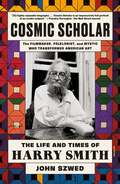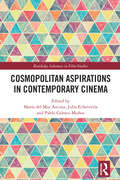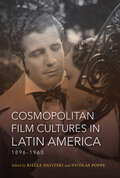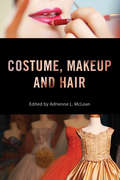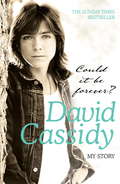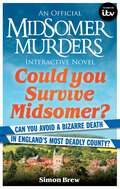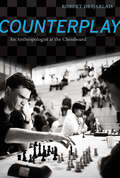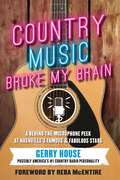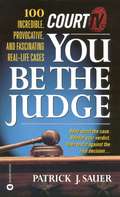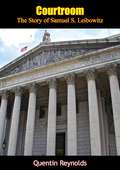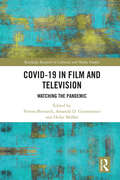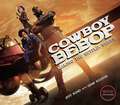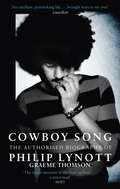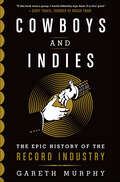- Table View
- List View
Cosmic Scholar: The Life and Times of Harry Smith
by John SzwedNamed one of the Best Books of 2023 by the New Yorker and The New York Times' Dwight Garner“The first comprehensive biography of this hipster magus . . . [John Szwed] allows different sides of Smith’s personality to catch blades of sun. He brings the right mixture of reverence and comic incredulity to his task.” —Dwight Garner, The New York TimesGrammy Award–winning music scholar and celebrated biographer John Szwed presents the first biography of Harry Smith, the brilliant eccentric who transformed twentieth century art and culture.He was an anthropologist, filmmaker, painter, folklorist, mystic, and walking encyclopedia. He taught Patti Smith and Robert Mapplethorpe about the occult, swapped drugs with Timothy Leary, had a front-row seat to a young Thelonious Monk, lived with (and tortured) Allen Ginsberg, was admired by Susan Sontag, and was one of the first artists funded by Guggenheim Foundation. He was always broke, generally intoxicated, compulsively irascible, and unimpeachably authentic. Harry Smith was, in the words of Robert Frank, “the only person I met in my life that transcended everything.”In Cosmic Scholar, the Grammy Award-winning music scholar and celebrated biographer John Szwed patches together, for the first time, the life of one of the twentieth century’s most overlooked cultural figures. From his time recording the customs of Native American tribes in the Pacific Northwest and Florida to his life in Greenwich Village in its heyday, Smith was consumed by an unceasing desire to create a unified theory of culture. He was an insatiable creator and collector, responsible for the influential Anthology of American Folk Music and several pioneering experimental films, but was also an insufferable and destructive eccentric who was unable to survive in regular society, or keep himself healthy or sober.Exhaustively researched, energetically told, and complete with a trove of images, Cosmic Scholar is a feat of biographical restoration and the long overdue canonization of an American icon.Includes black-and-white and color images
Cosmopolitan Aspirations in Contemporary Cinema (Routledge Advances in Film Studies)
by Pablo Gómez-Muñoz Julia Echeverría María del Mar AzconaThis book presents cosmopolitanism as a useful methodological approach to understand the transnational synergies present in contemporary cinema.In line with existing literature from the social sciences, the volume aims to contribute to the ‘cosmopolitan turn’ in cinema studies. It considers cosmopolitanism as, among others, a personal and social aspiration of social justice, world citizenship and celebration of difference; a notion to be criticised as elitist, Western, often imperialist, and homogenising; and an actually existing social practice characterised by contradiction, messiness and conflict. The chapters in this volume offer insights into the variety of sometimes contradictory discourses that arise from a cosmopolitan interpretation of a wide variety of film texts. Key topics explored in this book include borders, (im)mobilities, migration, race, class and film aesthetics.This book will be particularly useful to film studies scholars and students looking at transnational, global, world and decolonial cinemas and focusing on topics like borders, migration and multiculturalism in film. This book will also appeal to academic communities studying media, literature, mobilities, geopolitics, sociology and the social sciences in general.
Cosmopolitan Film Cultures in Latin America, 1896–1960 (New Directions in National Cinemas)
by Rielle Navitski and Nicolas PoppeCosmopolitan Film Cultures in Latin America examines how cinema forged cultural connections between Latin American publics and film-exporting nations in the first half of the twentieth century. Predating today's transnational media industries by several decades, these connections were defined by active economic and cultural exchanges, as well as longstanding inequalities in political power and cultural capital. The essays explore the arrival and expansion of cinema throughout the region, from the first screenings of the Lumière Cinématographe in 1896 to the emergence of new forms of cinephilia and cult spectatorship in the 1940s and beyond. Examining these transnational exchanges through the lens of the cosmopolitan, which emphasizes the ethical and political dimensions of cultural consumption, illuminates the role played by moving images in negotiating between the local, national, and global, and between the popular and the elite in twentieth-century Latin America. In addition, primary historical documents provide vivid accounts of Latin American film critics, movie audiences, and film industry workers' experiences with moving images produced elsewhere, encounters that were deeply rooted in the local context, yet also opened out onto global horizons.
Costume Design in the Movies: An Illustrated Guide to the Work of 157 Great Designers
by Elizabeth LeeseFascinating, comprehensive reference work provides biographical/career data for major American, British, and French designers since 1909: Theoni V. Aldredge (The Great Gatsby), Edith Head, (The Greatest Show on Earth), Orry-Kelly (An American in Paris), Irene Sharaff (Funny Girl) and many others. Updated to 1988. 177 illustrations, invaluable index of 6,000 films.
Costume in Motion: A Guide to Collaboration for Costume Design and Choreography
by Shura PollatsekCostume in Motion is a guide to all stages of the collaboration process between costume designers and choreographers, documenting a wide range of approaches to the creation of a dance piece. Featuring interviews with a diverse selection of over 40 choreographers and designers, in-depth case studies of works by leading dance companies, and stunning original photography, the book explores the particular challenges and creative opportunities of designing for the body in motion. Filled with examples of successful collaborations in contemporary and modern dance, as well as a wide range of other styles, Costume in Motion provides costume designers and choreographers with a greater understanding of the field from the other’s perspective. The book is designed to be part of the curriculum for an undergraduate or graduate level course in costume design or choreography, and it can also be an enriching read for artists at any stage of their careers wishing to hone their collaboration skills in dance.
Costume, Makeup, and Hair
by Robin Blaetz Tamar Jeffers Mcdonald Prudence Black Adrienne L. Mclean Drake Stutesman James Castonguay Karen De Perthuis Mary DesjardinsMovie buffs and film scholars alike often overlook the importance of makeup artists, hair stylists, and costumers. With precious few but notable exceptions, creative workers in these fields have received little public recognition, even when their artistry goes on to inspire worldwide fashion trends. From the acclaimed Behind the Silver Screen series, Costume, Makeup, and Hair charts the development of these three crafts in the American film industry from the 1890s to the present. Each chapter examines a different era in film history, revealing how the arts of cinematic costume, makeup, and hair, have continually adapted to new conditions, making the transitions from stage to screen, from monochrome to color, and from analog to digital. Together, the book's contributors give us a remarkable glimpse into how these crafts foster creative collaboration and improvisation, often fashioning striking looks and ingenious effects out of limited materials. Costume, Makeup, and Hair not only considers these crafts in relation to a wide range of film genres, from sci-fi spectacles to period dramas, but also examines the role they have played in the larger marketplace for fashion and beauty products. Drawing on rare archival materials and lavish color illustrations, this volume provides readers with both a groundbreaking history of film industry labor and an appreciation of cinematic costume, makeup, and hairstyling as distinct art forms.
Could It Be Forever? My Story: My Story
by David CassidyThis ebook edition contains the full text version as per the book. Doesn't include original photographic and illustrated material. In the seventies, when he was just 20 years old, David Cassidy achieved the sort of teen idol fame that is rarely seen. He was mobbed everywhere he went. His clothes were regularly ripped off by adoring fans. He sold records the world over. He was bigger than Elvis. And all thanks to a hit TV show called The Partridge Family. Now, in his own words, this is a brutally frank account of those mindblowing days of stardom in which being David Cassidy played second fiddle to being Keith Partridge. Including stories of sex, drugs and rock'n'roll that explode the myth of Cassidy as squeaky clean, it's also the story of how to keep on living life and loving yourself when the fickle fans fall away.
Could You Survive Midsomer?: Can you avoid a bizarre death in England's most dangerous county?
by Simon BrewAll is not well in the beautiful county of Midsomer. On the eve of its first Villages In Bloom competition, a man lies dead, smelling of damson jam. Who could have done it?Well, that's where you come in. Step into the shoes of Midsomer CID's newest recruit, choose your own path and decide which way the story goes.Will you get to the bottom of the mystery? Will you bring the perpetrator to justice? And perhaps most importantly of all, could you avoid an untimely, and possibly bizarre, death... will YOU survive Midsomer? Your task is to make the right choices, solve the case and - most tricky of all - stay alive!... Good luck.An official Midsomer Murders Interactive novel set in ITV's most celebrated and murderous county.
Could You Survive Midsomer?: Can you avoid a bizarre death in England's most dangerous county?
by Simon BrewAll is not well in the beautiful county of Midsomer. On the eve of its first Villages In Bloom competition, a man lies dead, smelling of damson jam. Who could have done it?Well, that's where you come in. Step into the shoes of Midsomer CID's newest recruit, choose your own path and decide which way the story goes.Will you get to the bottom of the mystery? Will you bring the perpetrator to justice? And perhaps most importantly of all, could you avoid an untimely, and possibly bizarre, death... will YOU survive Midsomer? Your task is to make the right choices, solve the case and - most tricky of all - stay alive!... Good luck.An official Midsomer Murders Interactive novel set in ITV's most celebrated and murderous county.
Counter-Archive: Film, The Everyday, and Albert Kahn's Archives de la PlanÈte
by Paula AmadFrom 1908 to 1931, French banker Albert Kahn financed a monumental multimedia archive intended to record the "surface of the globe as inhabited and developed by Man." Stored in a world-themed garden on the outskirts of Paris, the Archives de la Planète contained 4,000 stereoscopic plates, 72,000 autochromes, and 183,000 meters of film, composing one of the twentieth century's most impressive attempts to preserve a memory of the world through media. Moving beyond a traditional focus on fiction films screened for theatrical release, this book introduces new perspectives on motion picture history through an analysis of Kahn's rarely screened, unedited nonfiction films. Kahn's fragmented footage reveals diverse intellectual influences, including the philosophy of Henri Bergson (Kahn's lifelong mentor), the rise of human geography as practiced by Jean Brunhes (the director of the archive), and the scientific experiments of the biologist Jean Comandon (a pioneering microcinematographer who also contributed to Kahn's work). Amad also connects the Archive to an obsession with the everyday in early French film theory, the evolution of international documentary film, the early Annales School of history, and the colonial impulses of visual mapping projects. Transforming our conception of the archive in the age of cinema, Amad advances an innovative theory of film's counter-archival potential based on the challenge it poses to what counts as history.
Counter-Archive: Film, the Everyday, and Albert Kahn's Archives de la Planète (Film and Culture Series)
by Paula AmadTucked away in a garden on the edge of Paris is a multimedia archive like no other: Albert Kahn's Archives de la Planète (1908-1931). Kahn's vast photo-cinematographic experiment preserved world memory through the privileged lens of everyday life, and Counter-Archive situates this project in its biographic, intellectual, and cinematic contexts. Tracing the archive's key influences, such as the philosopher Henri Bergson, the geographer Jean Brunhes, and the biologist Jean Comandon, Paula Amad maps an alternative landscape of French cultural modernity in which vitalist philosophy cross-pollinated with early film theory, documentary film with the avant-garde, cinematic models of temporality with the early Annales school of history, and film's appropriation of the planet with human geography and colonial ideology. At the heart of the book is an insightful meditation upon the transformed concept of the archive in the age of cinema and an innovative argument about film's counter-archival challenge to history. The first comprehensive study of Kahn's films, Counter-Archive also offers a vital historical perspective on debates involving archives, media, and memory.
Counterfeit Worlds: The Cinematic Universes of Philip K. Dick
by Brian J. RobbDive into the worlds of Philip K. Dick who inspired some of the most famous sci-fi movies of all time! Philip K. Dick struggled to make a living during his lifetime, but his work has since served as a deep seam of ideas to be mined by filmmakers such as Ridley Scott, Paul Verhoeven, Steven Spielberg, John Woo and Richard Linklater, resulting in some of the most successful and influential SF movies of all time. For the still-unequalled future world of Blade Runner to the mind-bending A Scanner Darkly, via the blockbusting action/adventure of Total Recall, Paycheck and Minority Report – not to mention the debt of gratitude films like The Matrix and The Truman Show owe to his work – the legacy of Philip K. Dick has revolutionised Hollywood.
Counterplay: An Anthropologist at the Chessboard
by Robert R. Desjarlais"Chess gets a hold of some people, like a virus or a drug," writes Robert Desjarlais in this absorbing book. Drawing on his lifelong fascination with the game, Desjarlais guides readers into the world of twenty-first-century chess to help us understand its unique pleasures and challenges, and to advance a new "anthropology of passion." Immersing us directly in chess's intricate culture, he interweaves small dramas, closely observed details, illuminating insights, colorful anecdotes, and unforgettable biographical sketches to elucidate the game and to reveal what goes on in the minds of experienced players when they face off over the board. Counterplay offers a compelling take on the intrigues of chess and shows how themes of play, beauty, competition, addiction, fanciful cognition, and intersubjective engagement shape the lives of those who take up this most captivating of games.
Country House: Polish Theatre Archive
by Stanislav I. Witkiewicz D. GerouldCountry House, a ''comedy with corpses,'' is a wicked subversion of all those realistic psychological dramas of jealousy, adultery, murder and suicide that ask to be taken seriously. Witkacy's send-up assumes the form of a ghost story full of surprises, in the course of which an entire family of four is gleefully dispatched to the other world. When it was first performed in 1923 in Torun, Country House was judged unsuitable for the general public because it derided moral, social and dramatic convention. Three years later, as directed by the playwright himself in Lwów, the drama proved an unexpected success with audiences (although it only ran for four nights) and ever since has been among Witkacy's most frequently performed works. Today we can appreciate Country House not only as a systematic demolition of stage realism, but also as an anxious probing of the elusive boundaries between life and death, exposing the ''dark places'' of the human psyche that make us laugh nervously.
Country Music Broke My Brain: A Behind-the-Microphone Peek at Nashville's Famous and Fabulous Stars
by Gerry HouseNashville is filled with stars and lovers and writers and dreamers. Nashville is also teeming with lunatics and grifters and dip wads and moochers. Gerry House fits easily into at least half of those categories. Someone would probably have to be brain-damaged or really damn talented to try to entertain professional entertainers over a decades-long radio show in Music City, USA. Fortunately, House is little of both. Host of the nationally syndicated, top-rated morning show, &“Gerry House & The Foundation" for more than 25 years, he has won virtually every broadcasting award there is including a place in the National Association of Broadcasters Hall of Fame. Gerry also spent that time deep inside the songwriting and recording world in Nashville. In Country Music Broke My Brain, Gerry tells his stories from the other side of the microphone. He reveals never-aired, never-before published conversations with country music's biggest names—Johnny Cash, Brad Paisley, and Reba McEntire to name a few—and leaves you with his own crazy antics that will either have you laughing or shaking your head in disbelief. With exclusive celebrity stories, humorous trivia and anecdotes, and broadcasting wisdom, this book is a treat for country music fans or for anyone who wants a good laugh.
Court TV: You Be The Judge
by Patrick J. SauerReaders examine the evidence in 100 real court cases, act as judge, and render a verdict. After sufficient debate, alone or with friends, the official outcome is revealed with a turn of the page. Readers can judge the essence of the case and provide their own interpretations of how law and order should have been handed down and, because the cases are real, see if their decisions match those of the American justice system.
Courtroom: The Story of Samuel S. Leibowitz (Select Bibliographies Reprint Ser.)
by Quentin ReynoldsThe thrilling story of Judge Samuel S. Leibowitz and the front page criminal cases that highlighted his career as the nation’s most famous trial lawyer.“Dramatic and exciting as they come…. All of the famous trials of the last quarter century are brought to life in this exciting book penned by a master writer. It is a raw and violent work and certainly tops in interest.”—LOS ANGELES Herald Express“Exciting reading is this record of a great lawyer. The stories recorded here, now within the framework of law and time, are even more fascinating than when they rated banner headlines in the daily press.”—CHICAGO Sun“This book is far more exciting than any detective story you are likely to encounter, for it is the real thing.”—CLEVELAND Press“COURTROOM is a book which will have many absorbed readers, and a book which should do much to correct any popular impression that may exist as to the probity of lawyers who practice at the criminal bar…breezy, fast moving, and frankly written.”—SAN FRANCISCO Chronicle
Cousin Betty
by Honoré De BalzacLa Cousine Bette (French pronunciation: [la kuzin bɛt], Cousin Bette) is an 1846 novel by French author Honoré de Balzac. Set in mid-19th century Paris, it tells the story of an unmarried middle-aged woman who plots the destruction of her extended family. Bette works with Valérie Marneffe, an unhappily married young lady, to seduce and torment a series of men. One of these is Baron Hector Hulot, husband to Bette's cousin Adeline. He sacrifices his family's fortune and good name to please Valérie, who leaves him for a tradesman named Crevel. The book is part of the Scènes de la vie parisienne section of Balzac's novel sequence La Comédie humaine ("The Human Comedy").
Cousin Pons
by Honoré De BalzacMild, harmless and ugly to behold, the impoverished Pons is an ageing musician whose brief fame has fallen to nothing. Living a placid Parisian life as a bachelor in a shared apartment with his friend Schmucke, he maintains only two passions: a devotion to fine dining in the company of wealthy but disdainful relatives, and a dedication to the collection of antiques. When these relatives become aware of the true value of his art collection, however, their sneering contempt for the parasitic Pons rapidly falls away as they struggle to obtain a piece of the weakening man's inheritance. Taking its place in the Human Comedy as a companion to Cousin Bette, the darkly humorous Cousin Pons is among of the last and greatest of Balzac's novels concerning French urban society: a cynical, pessimistic but never despairing consideration of human nature.
Covid-19 in Film and Television: Watching the Pandemic (Routledge Research in Cultural and Media Studies)
by Verena Bernardi Amanda D. Giammanco Heike MißlerThis collection explores the impact of Covid-19 on the production and consumption of television and film content in the English-speaking world. Offering in-depth analysis of select on-screen entertainment, the volume addresses entertainment’s changing role during and following the Covid-19 pandemic. It also studies the pandemic’s incorporation into the narrative of numerous series, films, and other televised formats, capturing the moments and contexts in which these developments emerged. Chapters examine the pandemic’s impact both on a micro- and macro level, focusing on the content as well as form of TV shows and films. Bringing together an international team of scholars, the book offers a range of perspectives, exploring phenomena such as the ‘YouTubification’ of audience-reliant late-night television, as well as films and TV shows such as Superstore, Grey’s Anatomy, and The Good Fight.Given the pandemic’s lasting impact on the film and television industries, this book will be a valuable read for scholars studying audience and viewer reception of on-screen content, and the impact of crises on cultural industries. It will also appeal to researchers in cultural studies, popular culture studies, television studies, internet studies, film studies, and media studies more broadly.
Cowboy Bebop: Making The Netflix Series
by Jeff Bond Gene KozickiOfficial companion book to the Netflix TV series featuring concept art, sketches, behind-the-scenes photography and interviews with cast and crew.Based on the worldwide phenomenon from Sunrise Inc., Cowboy Bebop is the jazz-inspired, genre-bending story of a rag-tag crew of bounty hunters on the run from their pasts as they hunt down the solar system&’s most dangerous criminals. They&’ll even save the world…for the right price. Take a trip behind the scenes of Netflix&’s live-action Cowboy Bebop adaptation! This official companion book is packed full of beautiful concept art and revealing behind-the-scenes photography, as the cast and crew tell the story of how one of the most influential anime series of all time was translated over to live action in this much-anticipated series.
Cowboy Song: The Authorised Biography of Philip Lynott
by Graeme Thomson'The truest measure of the man we have thus far' - Mojo'Affectionate, impeccably researched biography' - Mail on Sunday'Head and shoulders above the usual rock hagiography' - Sunday TelegraphThe first biography to be written with the cooperation of the Lynott Estate, Cowboy Song is the definitive authorised account of the extraordinary life and career of Thin Lizzy guiding spirit, Philip Lynott.Leading music writer Graeme Thomson explores the fascinating contradictions between Lynott's unbridled rock star excesses and the shy, sensitive 'orphan' raised in working class Dublin. The mixed-race child of a Catholic teenager and a Guyanese stowaway, Lynott rose above daunting obstacles and wounding abandonments to become Ireland's first rock star. Cowboy Song examines his key musical alliances as well as the unique blend of cultural influences which informed Lynott's writing, connecting Ireland's rich reserves of music, myth and poetry to hard rock, progressive folk, punk, soul and New Wave.Published on the thirtieth anniversary of Lynott's death in January 1986, Thomson draws on scores of exclusive interviews with family, friends, band mates and collaborators. Cowboy Song is both the ultimate depiction of a multi-faceted rock icon, and an intimate portrait of a much-loved father, son and husband.
Cowboy Song: The Authorised Biography of Philip Lynott
by Graeme Thomson'The truest measure of the man we have thus far' - Mojo'Affectionate, impeccably researched biography' - Mail on Sunday'Head and shoulders above the usual rock hagiography' - Sunday TelegraphThe first biography to be written with the cooperation of the Lynott Estate, Cowboy Song is the definitive authorised account of the extraordinary life and career of Thin Lizzy guiding spirit, Philip Lynott.Leading music writer Graeme Thomson explores the fascinating contradictions between Lynott's unbridled rock star excesses and the shy, sensitive 'orphan' raised in working class Dublin. The mixed-race child of a Catholic teenager and a Guyanese stowaway, Lynott rose above daunting obstacles and wounding abandonments to become Ireland's first rock star. Cowboy Song examines his key musical alliances as well as the unique blend of cultural influences which informed Lynott's writing, connecting Ireland's rich reserves of music, myth and poetry to hard rock, progressive folk, punk, soul and New Wave.Published on the thirtieth anniversary of Lynott's death in January 1986, Thomson draws on scores of exclusive interviews with family, friends, band mates and collaborators. Cowboy Song is both the ultimate depiction of a multi-faceted rock icon, and an intimate portrait of a much-loved father, son and husband.
Cowboys and Aliens
by Universal PicturesBlockbuster filmmaker Jon Favreau directs Daniel Craig and Harrison Ford in a film that crosses the classic Western with the alien-invasion movie in a blazingly original way: Cowboys & Aliens. Joined by an arsenal of top moviemakers-Steven Spielberg, Ron Howard, Brian Grazer, Alex Kurtzman and Roberto Orci-he brings an all-new action thriller that will take audiences into the Old West, where a lone cowboy leads an uprising against a terror from beyond our world.1875. New Mexico Territory. A stranger (Craig) with no memory of his past stumbles into the hard desert town of Absolution. The only hint to his history is a mysterious shackle that encircles one wrist. What he discovers is that the people of Absolution don't welcome strangers, and nobody makes a move on its streets unless ordered to do so by the iron-fisted Colonel Dolarhyde (Ford). It's a town that lives in fear.But Absolution is about to experience fear it can scarcely comprehend as the desolate city is attacked by marauders from the sky. Screaming down with breathtaking velocity and blinding lights to abduct the helpless one by one, these monsters challenge everything the residents have ever known.Now, the stranger they rejected is their only hope for salvation. As this gunslinger slowly starts to remember who he is and where he's been, he realizes he holds a secret that could give the town a fighting chance against the alien force. With the help of the elusive traveler Ella (Olivia Wilde), he pulls together a posse comprised of former opponents-townsfolk, Dolarhyde and his boys, outlaws and Apache warriors-all in danger of annihilation. United against a common enemy, they will prepare for an epic showdown for survival.The script for Cowboys & Aliens is by Star Trek's Alex Kurtzman & Roberto Orci and Damon Lindelof (television's Lost), based on Platinum Studios' graphic novel created by Scott Mitchell Rosenberg. Grazer, Howard, Rosenberg, Kurtzman and Orci produce. Spielberg and Denis L. Stewart executive produce.
Cowboys and Indies: The Epic History of the Record Industry
by Gareth MurphyCowboys and Indies is nothing less than the first definitive history of the recording industry on both sides of the Atlantic.From the invention of the earliest known sound-recording device in 1850s Paris to the CD crash and digital boom today, author and industry insider Gareth Murphy takes readers on an immensely entertaining and encyclopedic ride through the many cataclysmic musical, cultural, and technological changes that shaped a century and a half of the industry.This invaluable narrative focuses especially on the game changers---the label founders, talent scouts, and legendary A&R men. Murphy highlights:· Otto Heinemann's pioneer label Okeh, which spread blues and jazz "race" records across America· how one man, Henry Speir, discovered nearly all the Delta blues legends (Robert Johnson, Charlie Patton, Son House, Tommy Johnson) · Sam Phillips's seminal work with Chess and Sun Records· John Hammond's discoveries (Billie Holiday, Aretha Franklin, Bob Dylan, Leonard Cohen, Bruce Springsteen) · the behind-the-scenes players of the British Invasion· Clive Davis, Ahmet Ertegun, David Geffen, and the corporate music machine· the Machiavellian moves of punk impresario Malcolm McLaren (Sex Pistols)· Chris Blackwell's triumphs for Island Records (Bob Marley, U2)· Sylvia Robinson and Tom Silverman, the hip-hop explorers behind the Sugarhill Gang, Grandmaster Flash, and Afrika Bambaataa...and much, much more. Murphy also offers a provocative look at the future through the ruminations of such vanguard figures as Martin Mills (4AD, XL Recordings, Matador, Rough Trade) and genre-busting producer Rick Rubin (Run-D.M.C., Red Hot Chili Peppers, Metallica, Johnny Cash).Drawing from memoirs, archives, and more than one hundred exclusive interviews with the legends of the record industry, including the founders and CEOs of Atlantic, Chrysalis, Virgin, A&M, Sub Pop, and Sire, this book reveals the secret history behind the hit-making craft. Remarkable in scope and impressive in depth, Cowboys and Indies chronicles the pioneers who set the stylus on the most important labels and musical discoveries in history.
